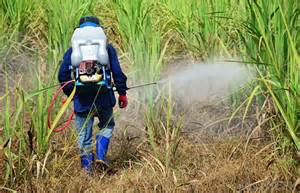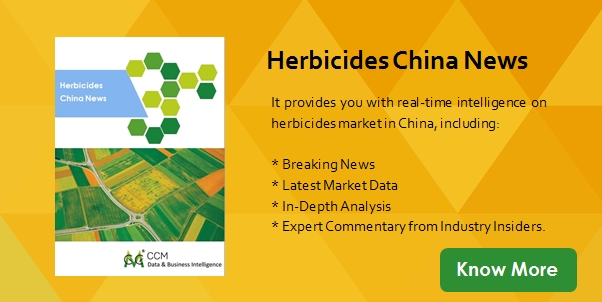Glufosinate-ammonium, one of the four major
sterilant herbicides in the globe, has been a rising star in 2016 thanks to the
exit of paraquat in the world's pesticide market.

Source: Bing
As the four major sterilant herbicides in
the world, glyphosate, paraquat, glufosinate-ammonium and diquat have their own
characteristics in killing weeds. Glyphosate is able to kill the roots of weeds
completely. Paraquat is memorable because of its speed in killing weeds, which only takes it 30 minutes. Diquat is very similar with paraquat except for its
narrower range of weeds when it comes to controlling. As for glufosinate-ammonium,
different from glyphosate, it kills the weeds from their leaves instead of
roots through plant transpiration with its initial effect time between those of
paraquat and glyphosate.
In fact, glufosinate-ammonium has been
living under the shadow of paraquat for more than 30 years, which began to be
used in controlling conyza canadensis and goosegrass. Gradually, it was widely
used in coastal areas in China. Finally, glufosinate-ammonium got its big
chance to surpass paraquat after the first decade of 21st century.
Due to the high possibility of mis-ingestion
of paraquat AS, different countries and areas began to ban the sales of
paraquat after 2010. South Korea and Taiwan China were the first to completely
ban the sales of paraquat in Asia. It was not until 2014 that China stopped the
paraquat registrations. And since July 1 2016, sales of paraquat AS have been
completely banned in China.
Hebei Veyong Bio-Chemical Co., Ltd. (Hebei
Veyong) and Zhejiang Yongnong Chem. Ind. Co., Ltd. (Zhejiang Yongnong) were
probably the first enterprises to develop and produce glufosinate-ammonium in
China. After the acceptance of glufosinate-ammonium in Guangdong Province,
Hainan Province and Fujian Province, the use of glufosinate-ammonium began to
expand to inland, which showed a sign of a spring of glufosinate-ammonium.
In fact, at the end of 2014, the pesticide
industry in China made the same judgment on glufosinate-ammonium. It would be a
spring for glufosinate-ammonium after 2015, and the ban of paraquat would be a
climax for glufosinate-ammonium development in China. At the end of 2014, Hebei
Veyong began its 500t/a glufosinate-ammonium project and expanded the capacity
again in 2015.
A flashback on glufosinate-ammonium market
in China in 2015: Due to strong demand of glufosinate-ammonium TC and limited
capacity in 2015, the price of glufosinate-ammonium TC once reached
RMB340,000/t and stabilized at around RMB300,000/t, which was a great time for
technical producers to make money.
As for the production of glufosinate-ammonium
formulations, Hebei Veyong, Zhejiang Yongnong and Lier Chemical Co., Ltd. (Lier
Chemical) got their great development chances due to the abnormal supply of glufosinate-ammonium
formulations from Bayer CropScience AG (Bayer CropScience). The prices of glufosinate-ammonium
formulations stabilized at RMB80,000 t/a, whose profits for enterprises were
much lower than that of glufosinate-ammonium TC. However, the above three
enterprises were capable to compete in the pesticide market even with lower
profits and that was why some formulation giants such as Shenzhen Noposion
Agrochemicals Co., Ltd., Guangxi Tianyuan Biochemistry Co., Ltd. and Beijing
Yoloo Pesticide Co., Ltd. stopped their pace in 2015.
Thus, there were not many glufosinate-ammonium
products in the market in 2015 and the supply of glufosinate-ammonium products
was not enough, which was a good opportunity for the major glufosinate-ammonium
producers --- Hebei Veyong, Zhejiang Yongnong and Lier Chemical.
Most of the producers held a positive attitude
toward the glufosinate-ammonium industry till the 2015 AgroChemEx held in Oct.
2015 because there was about 20,000t/a new capacity of glufosinate-ammonium to
be released in the market in Aug.
Moreover, it was predicted that there was
at least 10,000t/a new capacity of glufosinate-ammonium in the market in 2016
with the expected total capacity reached 50,000t/a in 2017. So why do insiders
still have a good expectation on glufosinate-ammonium industry? It was mainly
because of the huge market left by the ban of paraquat.

Paraquat AS, which had been in China's
pesticide market for 32 years, finally exited the market in July 1 2016. With its
formulation sales of over 100,000 t/a in China, paraquat captured a huge market
share. As for the global market, the sales of paraquat formulation were over 300,000
tonnes in 2015.
With the 400,000 tonne of paraquat
formulation left by the exit of paraquat, it was believed that glufosinate-ammonium
would have its biggest chance to develop.
Thus, many of the pesticide producers all
tried to capture the market and believed that glufosinate-ammonium was the only
substitute for paraquat.
However, the development of glufosinate-ammonium
didn't go as what it was expected and even fell into a long decline, which was
mainly caused by the return of Bayer CropScience.
In Jan. 2016, Basta (glufosinate-ammonium SL
18%), Bayer CropScience's product, returned to the market after the tight supply
in China's market. The price of Basta even declined to RMB80,000-100,000/t from
RMB120,000-140,000/t in Jan. 26 2016. In the meanwhile, Bayer CropScience also
announced that it would guarantee the supply in the China's market in 2016.
What happened next? Zhejiang Yongnong, Lier
Chemical and Hebei Veyong all followed the trend and decreased the price of glufosinate-ammonium
products. The price of Lier Chemical glufosinate-ammonium product declined to
RMB70,000-75,000/t from RMB100,000/t. So did the price of Zhejiang Yongnong glufosinate-ammonium
product. As for Hebei Veyong, its glufosinate-ammonium product fell to
RMB75,000-80,000/t.
The controversy whether the price decline
was the market discipline or war price has not stopped since the beginning of
2016.
In fact, the first round of decline in Jan.
– Mar. 2016 was reasonable because the price of glufosinate-ammonium formulation
was much higher than that of paraquat which increased the cost for farmers. The
decline on glufosinate-ammonium price would make it easier for farmers to
accept this substitute of paraquat.
However, the price kept falling in April in
2016, from RMB58,000/t to RMB52,000/t, then to RMB43,000/t and in July, it even
fell to RMB295,000/t.
In only a one-year time, glufosinate-ammonium
has been through its up and down. The future of glufosinate-ammonium is still
changeable.
About CCM:
CCM is the leading market intelligence
provider for China's agriculture, chemicals, food & ingredients and life
science markets. Founded in 2001, CCM offers a range of data and content
solutions, from price and trade data to industry newsletters and customized
market research reports. Our clients include Monsanto, DuPont, Shell, Bayer,
and Syngenta. CCM is a brand of Kcomber Inc.
For more information about CCM, please
visit www.cnchemicals.com or get in
touch with us directly by emailing econtact@cnchemicals.com or calling +86-20-37616606.